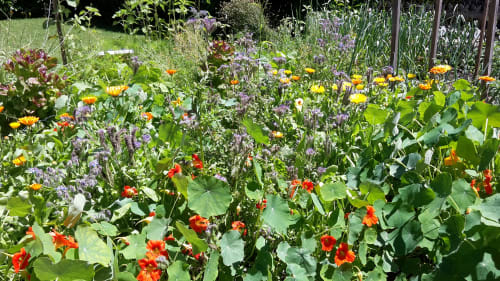
My parents had a huge vegetable garden that would almost self-sustain us, a family of six. When I was a kid, I don't remember us ever having to buy vegetables from the supermarket. My mother, who was a homemaker, used to spend most of her days in the garden and my father would join her in the evenings and on Saturdays. We, the kids, also had to do our garden chores, especially during the summer holidays. I hated them and took every opportunity to steal away in order to play in the neighbor's sandbox.
But obviously, something must have stuck. I now have a small garden where I am growing some vegetables like tomatoes (Solanum lycopersicum), garlic (Allium sativum), onions (Allium cepa), potatoes (Solanum tuberosum) and lettuce (Lactuca sativa), but also a lot of flowers like sunflowers (Helianthus), cosmos (Cosmos), marigolds (Calendula officinalis), lavender (Lavandula), borage (Borago officinalis), nasturtiums (Tropaeolum) and scorpionweed (Phacelia). Recently, I've also added some perennial plants like a cherry tree (Prunus cerasus), an apple tree (Malus domestica) and several varieties of raspberries (Rubus). Many of the plants I have in the garden are so-called old heirloom varieties, of which I save the seeds in order to perpetuate them. I am also part of a national seed-sharing network which allows me to try out other varieties. Little by little, I'm also transforming part of my lawn into a wildflower meadow in order to contribute to stopping the biodiversity collapse. I wouldn't be consistent with my ideals if I allowed the use of chemical pesticides or fertilizers, so the garden is one hundred percent organic.
As you can see, my garden is very far from being a self-sustaining one like that of my parents' back then. However, it is a strong political statement against pesticides and patents on seeds, as well as for biodiversity. Even though I had heard of these topics in the past, I got much more involved when I joined a CSA (Community Supported Agriculture) project almost ten years ago. The contact with the professional vegetable growers and farmers, their explanations on how the dots are connected, the tools and techniques we apply on the farm, all that helped raise my awareness of these topics. And ultimately led me to take action. I now always have my soil covered with mulch or growing plants. Moreover I don't till my soil any more with the goal of trying to preserve the invaluable topsoil and the invisible biodiversity in it.
The CSA also put me wise to other political topics around food like foodwaste, food security, the extinction of small farmers while huge industrial farms are booming and, last but not least, the climate emergency. But I will hold back from going deeper into these topics, as it would go way beyond the scope of this journal entry.

Ah, cool stuff! I've decided I just don't have the energy for maintaining a self-sufficient veggie garden myself--I just keep a few peppers or tomatoes in pots. But I love trying out heritage breeds, and there's usually someone selling heritage tomato seedlings at our farmer's market.
This is very interesting, I am sadly one of those people who manage to make every plant in my care perish... even the cactus my daughter gave me. Everything usually grows better if I leave it alone. I have not given up, yet. I have a book called Square Foot Gardening on my shelf and intend to use a container to try myself on one or two squares this spring. Also, the neighbors' sandbox would mean that several neighbors own one sandbox together. If one neighbor owns one sandbox, it should be the neighbor's sandbox. I have to admit, I admire your ability to know the comma rules of English because even though German is my mother tongue, I have studied in the US and cannot remember the comma rules, or apostrophe rules, for German at all.
@Janewt, yeah, self-sufficient is really a lot of work. It's a very good idea trying out heritage breeds, especially tomatoes, because the commercial hybrids have been bred so that they don't get squidged during transport and can stay for several days in the supermarket. Heirloom varieties from your own garden on the other side can be picked up and processed without delay in the kitchen, so no need for them to have a thick skin and stay fresh long (with less flavor in exchange)
@Silly7, I've heard of the book Square Foot Gardining. It's a great idea to start with that and learn to know your plants better. Don't worry about killing them, one learns with their mistakes and you'll get better from year to year. About your "neighbors' sandbox" comment: my understanding is that my neighbors are the people living next to our house, so they are a plural. I understand that you mean neighbor=neighboring house, and in that case, it would be in the singular. Is my assumption wrong? About the commas: I do make some comma mistakes in English, I've seen that in my previous post :-D. But thanks anyway!
@eco-erich, I really had give that some more thought and see what others think. I think I would use neighbor as a collective noun in your sentence and stick with the neighbor's sandbox. My understanding is that this is an acceptable use of neighbor even though it is not originally a collective noun. Good luck with your plants this year!
If you want to get particular about neighbors' vs. neighbor's, obviously either could be a correct formation, but as a native speaker I'd lean towards neighbors'. Given the discussion--a description of a specific real garden, sandbox, etc.--if the specific real neighbors were multiple people, go with neighbors'.
Thanks to everyone for the wonderful comments. I feel I am learning by the day :)